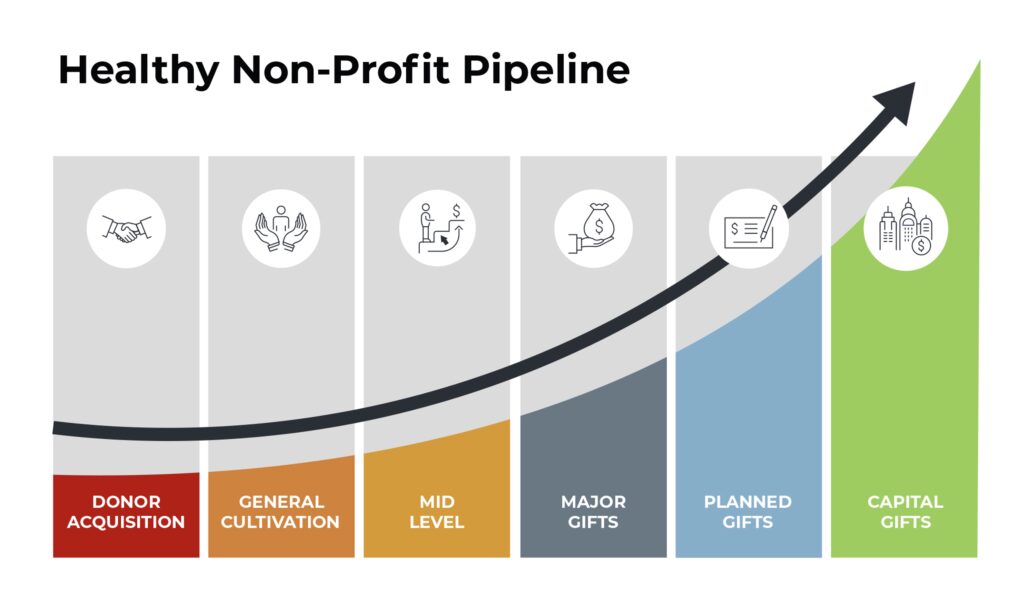We write about creating a healthy donor pipeline (pictured below) all the time. Why? Because we are advocates for donors and frontline fundraisers. I know that answer might sound odd, but let me explain.
When you have a healthy donor pipeline, you’re allowing donors to give as easily, and as much as possible, to the projects and programs they feel passionate about as it relates to your mission. Secondly, with a healthy pipeline, frontline fundraisers have portfolios full of donors who want a relationship with them, who want to be inspired by offers that touch the depths of their soul. And for a frontline fundraiser, that’s exactly the type of donor you want in your portfolio because you know you can be successful with them.

But we screw it up. We create clogs in the pipeline and make it nearly impossible for donors to do what they want to do. So, donors give less, or they stop giving. This causes fewer donors to move into mid and major gift portfolios, which causes Executive Directors and DoD’s to tell you to start looking for wealthy people who have no interest in your organization at the next Rotary Club meeting.
Yep, this is why so many frontline fundraisers are asked to “prospect” outside of the donor database (which is always a disaster) because no one at the organization is minding the pipeline.
You have donors right now in your database that either want to or will be a major or planned giving donor, but you won’t find them because they are stuck in your donor pipeline.
Here is what it looks like from an actual organization we have done an assessment for:

What you’re looking at is a snapshot of our pipeline analysis of cume giving levels. Notice at the $1,000-$4,999 level, there are over 3,800 donors bringing in over $6MM. But then look at the dramatic drop-off of donors at the next cume giving level of $5,000-$9,999 – only 263 donors.
A massive clog!
This is just one example, but we see these clogs up and down the pipeline at different cume giving levels. Most organizations don’t know this is happening. In this particular organization, they had no mid-level program, and their major gift program started at $5,000 cume and above.
Leadership at the organization were telling the major gift team to “get out there and prospect” for new major donors. But they were right there in their donor base. No one was reaching out to donors in the $1,000-$4,999 cume giving range!!
But after seeing this analysis, they asked us to help them start a mid-level program. Guess what’s happening now? Donors are moving into major gift portfolios! And no one’s talking about going to any more Rotary Club meetings to scope out prospects.
Here are some things you can do to help unclog your donor pipeline and create more joy for your donors and your frontline fundraisers:
-
Do the pipeline analysis from your database.
You can have Veritus analyze your data for free, or you can have your data manager do this. Either way, you must start with the data. The data will tell you the story of where your clogs are. Once you know that information, you can address it with strategy. Without this knowledge, you won’t know if the current strategies you have in place are effective in moving donors up and through the pipeline. For example, you may see a clog in your $100-$249.99 cume level donors. You might find that you are not challenging donors to upgrade their giving with dollar handle ask strategies with your direct-response program. Or you are not challenging sustainers with additional solicitations. Analyzing your data will help you ask the right questions here.
-
Analyze the investments you are making in each stage of the donor pipeline.
How much are you investing in new donor acquisition versus mid, major, and planned giving? Are you skewing your investment in one strategy versus another? Many times, we see organizations investing the vast majority of their resources on new donor acquisition and cultivation, but very little in mid, major, or planned giving. This could mean the ROI of the development program is too low and not providing enough net revenue for program growth. Or it could be the other way around. With a lack of investment in new donor acquisition, not enough donors are “feeding” the pipeline which causes stunted growth in the major gift program.
-
Review internal systems that could be causing clogs.
Do you have departments within your development team that are siloed and don’t talk to one another? Do you have KPIs set up that de-incentivize teams to help move donors up the giving pipeline? Is there a spirit within departments of, “I can’t give up my donors to mid and major gifts because it will hurt MY revenue?”
-
Create and build a mid-level program with mid-level officers.
Many non-profits have told us they have a mid-level program, but really, it’s a higher level direct-response program. Nothing wrong with that, but a true mid-level program has an actual mid-level officer that works to cultivate, steward, and solicit donors on top of what is already happening with the direct-response communication. A robust mid-level program starts to engage donors to find out their passions and interests and move them into major gift portfolios as qualified donors. A robust mid-level program will have a major impact on unclogging your pipeline.
Remember, the greatest thing you can do for your donors and your fundraisers is to ensure you always diligent about creating and maintaining a healthy donor pipeline. These four ideas will start to unclog that pipeline today!
Jeff
This post originally appeared on the Passionate Giving Blog on May 30, 2022.
![4 Ways to Unclog Your Donor Pipeline Today Data analyst reviews growth chart with team in office.[4 Ways to Unclog Your Donor Pipeline Today]](https://veritusgroup.com/wp-content/uploads/2022/05/AdobeStock_478801502-scaled.jpeg)
![5 Reasons Why We Love Mid-Level, And You Should Too! [Podcast Episode]](https://veritusgroup.com/wp-content/uploads/2022/11/Podcast-Episode-Blog-Post-Header-Image-5.png)
![Keep, Lift, Move: The Three Objectives of a Successful Mid-Level Program [New Podcast Episode]](https://veritusgroup.com/wp-content/uploads/2022/08/Podcast-Episode-Blog-Post-Header-Image_080822.png)




0 Comments